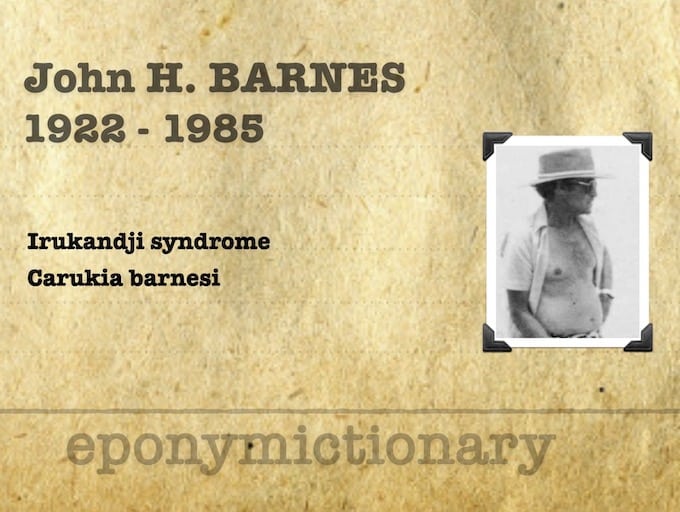
Jack Barnes and the Irukandji Enigma
In 1961, Jack Handyside Barnes, his nine year-old son, and a local surf lifesaver were rushed to Cairns Base Hospital after developing Irukandji syndrome.

In 1961, Jack Handyside Barnes, his nine year-old son, and a local surf lifesaver were rushed to Cairns Base Hospital after developing Irukandji syndrome.

Scombroid poisoning occurs after the ingestion of fish with high histamine levels due to improper processing or storage. One of the most common causes of morbidity associated with fish intake

John (Jack) Handyside Barnes (1922-1985) was an Australian medical practitioner and toxinologist. 1964 the first specimens of the small stinger Carukia barnesi (Irukandji)

Irukandji Syndrome - originally a mystery was solved by some self experimentation of Dr Jack Barnes, his nine-year old son and local surf lifesaver. He proved that the thumbnail sized carybdeid (or four tentacled box jellyfish) could cause Irukandji syndrome but placing it on all three of them.

Irukandji syndrome is a distressing envenoming secondary to the sting of Carukia barnesi and other, as yet unidentified, jellyfish found in coastal waters of tropical Australia.

Bluebottle Jellyfish are not actually a single organism but are made up of zooids. These bluebottles cause thousands of stings each year on Australian beaches and hot water usually provides relief. Major systemic envenoming does not occur (unlike other Physalia stings in other parts of the world).

The bluebottle jellyfish is responsible for thousands of stings on Australian beaches each year. Clinical features include intense local pain and dermal erythema. Hot water immersion provides safe symptomatic relief. Unlike Physalia stings in other parts of the world, major systemic envenoming does not occur.

Blue-Ringed Octopus bites usually occur if you are hanging around Bond villains or you pick these up and play with them, the venom comes from a beak under the body of the octopus and not the tentacles. Scarily you will will become paralysed soon after the bite but will be fully aware like a locked in syndrome.

The family Scorpaenidae (Scorpionfish) contains around 45 genera and 380 species. Scorpionfishes have large, heavily ridged heads and venomous spines on their back and fins.

Box Jellyfish Antivenom (ovine IgG Fab) can be used to treat envenomation from box jellyfish found in Australian Waters.

Ciguatera Poisoning: A bizarre poisoning syndrome with acute and sometimes severe neurological and gastrointestinal symptoms caused by eating tropical reef fish that have accumulated ciguatoxin from the dinoflagellate Gambierdiscus toxicus; most common cause of fish poisoning worldwide.

The box jellyfish is found in tropical Australian waters. Most stings are benign and respond to supportive measures. Severe envenoming has been associated with at least 67 deaths in Australia, the last 12 being children.